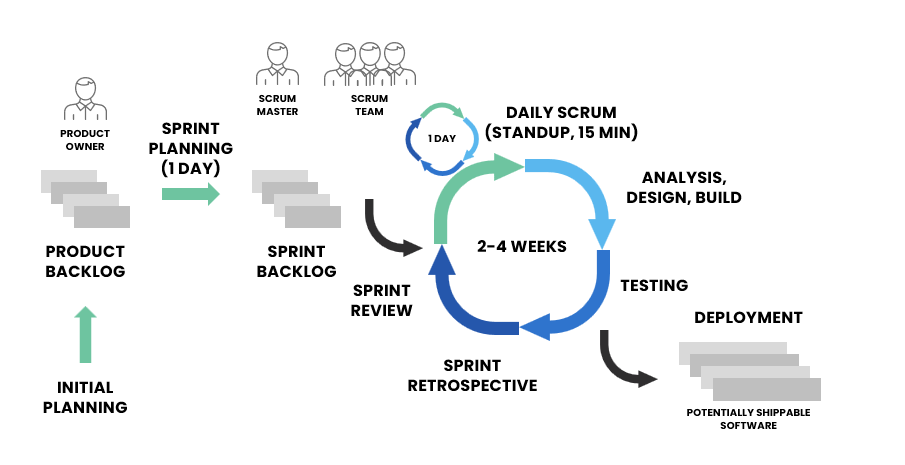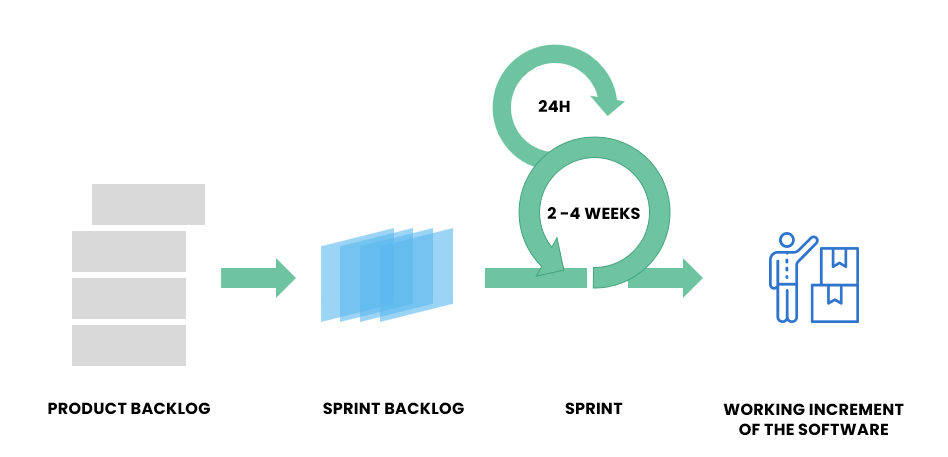A Guide to Agile Scrum: Framework, Roles, and Implementation
87% of companies that are using Agile methodologies are utilizing the Scrum framework, making it the most popular Agile approach. Agile Scrum is renowned for fostering flexibility, adaptability, and its emphasis on collaboration. This comprehensive guide delves into the principles, roles, events, and artifacts that define Scrum, offering insights into its real-world applications and benefits.
What is Agile Scrum?
Agile Scrum is a framework within the Agile methodology designed to manage and deliver complex projects iteratively. How agile scrum works is through breaking work into manageable sprints, Scrum ensures continuous improvement, collaboration, and faster delivery of high-value solutions.
Key Features of Scrum:
- Iterative Process: Work is divided into short cycles called sprints. Sprints can last between 1 and 4 weeks
- Collaborative Approach: Emphasis on teamwork and communication.
- Adaptability: Responds effectively to change and uncertainty.
- Customer-Centric: Prioritizes delivering value to stakeholders.
Roles in Agile Scrum
The success of Scrum hinges on well-defined roles that foster collaboration and accountability.
1. Product Owner
- Responsibilities:
- Define and prioritize the product backlog.
- Serve as the liaison between stakeholders and the development team.
- Ensure the team delivers maximum value.
- Key Skills:
- Strong communication and decision-making abilities.
- Deep understanding of customer needs and business objectives.
2. Scrum Master
- Responsibilities:
- Facilitate Scrum events and remove impediments.
- Guide the team in following Scrum principles.
- Act as a coach to the development team and stakeholders.
- Key Skills:
- Problem-solving and conflict-resolution expertise.
- Deep knowledge of Agile principles and practices.
3. Development Team
- Responsibilities:
- Design, build, and test increments during each sprint.
- Collaborate closely to meet sprint goals.
- Self-organize to manage their workload effectively.
- Key Skills:
- Technical expertise and creativity.
- Strong collaboration and adaptability.
Unfortunately Scrum does not have a defined Business Analyst role, however Business Analysts are crucial to Scrum success
Scrum Framework and Events
Scrum operates through a series of structured activities called scrum events or scrum ceremonies designed to ensure progress and alignment.
1. Sprint
- Definition: A time-boxed iteration, typically 2-4 weeks, where a deliverable increment is developed.
- Purpose: Promote focus and continuous delivery of value.
2. Sprint Planning
- Objective: Define sprint goals and select items from the backlog to address them.
- Participants: Product Owner, Scrum Master, and Development Team.
3. Daily Scrum
- Objective: Provide team members a platform to synchronize and identify blockers.
- Duration: 15 minutes.
- Sample Questions:
- What did you accomplish yesterday?
- What will you work on today?
- Are there any impediments in your way?
4. Sprint Review
- Objective: Present the completed work to stakeholders and gather feedback.
- Outcome: Refine future sprints based on feedback.
5. Sprint Retrospective
- Objective: Reflect on the sprint and identify opportunities for improvement.
- Focus Areas:
- What went well?
- What didn’t go well?
- What can be improved?
Scrum Artifacts
Scrum artifacts ensure transparency and alignment across teams.
1. Product Backlog
- Definition: A prioritized list of features, fixes, and tasks for the product.
- Ownership: Managed by the Product Owner.
2. Sprint Backlog
- Definition: A subset of the product backlog selected for the sprint.
- Ownership: Owned by the Development Team.
3. Increment
- Definition: A potentially shippable product deliverable resulting from a sprint.
- Significance: Demonstrates tangible progress.
Read more about managing sprints here.
The Benefits of Scrum
Organizations adopting Scrum experience several advantages:
- Faster Time-to-Market: Iterative cycles enable quicker delivery.
- Enhanced Collaboration: Encourages communication between all stakeholders.
- Improved Quality: Continuous testing and feedback ensure robust solutions.
- Increased Flexibility: Adaptability to evolving requirements.
Scrum Implementation Best Practices
1. Establish Clear Goals
Ensure alignment on sprint goals and overall project objectives to avoid confusion and scope creep.
2. Empower the Team
Encourage self-organization within the Development Team to foster ownership and innovation.
3. Leverage Technology
Use tools like Jira, Trello, or Azure DevOps to manage backlogs, track progress, and ensure transparency.
4. Foster a Culture of Improvement
Regularly conduct retrospectives and implement feedback to enhance processes.
Challenges in Scrum and How to Overcome Them
1. Resistance to Change
- Solution: Provide training and highlight the benefits of Agile Scrum.
2. Poorly Defined Roles
- Solution: Clearly communicate responsibilities and empower each role.
3. Inconsistent Participation
- Solution: Emphasize the importance of attendance in Scrum events.
Conclusion
Agile Scrum is a transformative framework that empowers teams to deliver high-quality solutions efficiently. By understanding its principles, roles, and events, organizations can maximize value and foster a culture of collaboration and continuous improvement. Whether you’re new to Scrum or looking to refine your approach, embracing these practices is the key to achieving project success.












